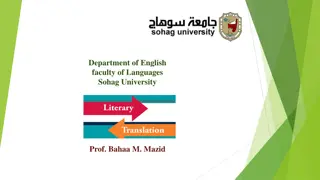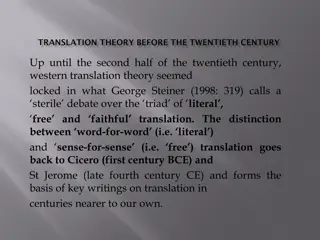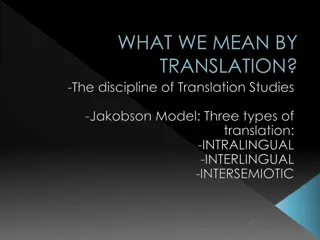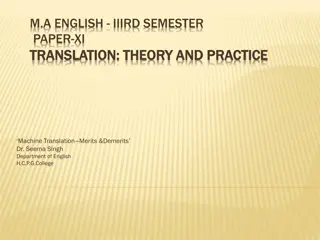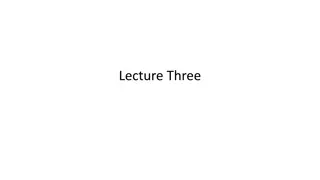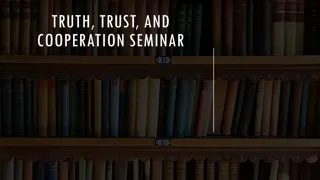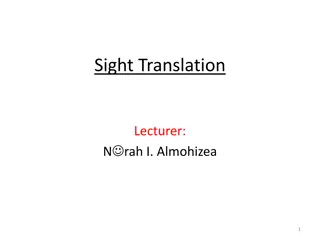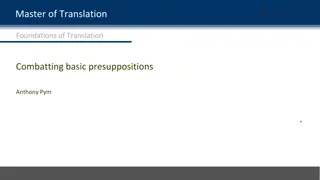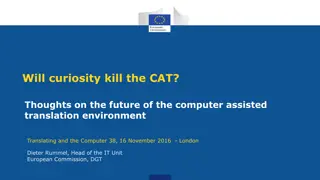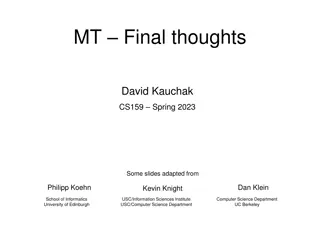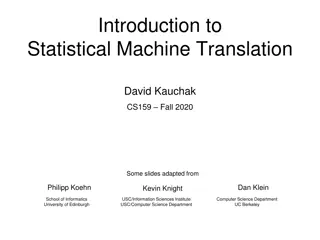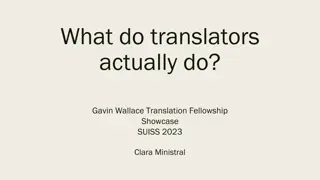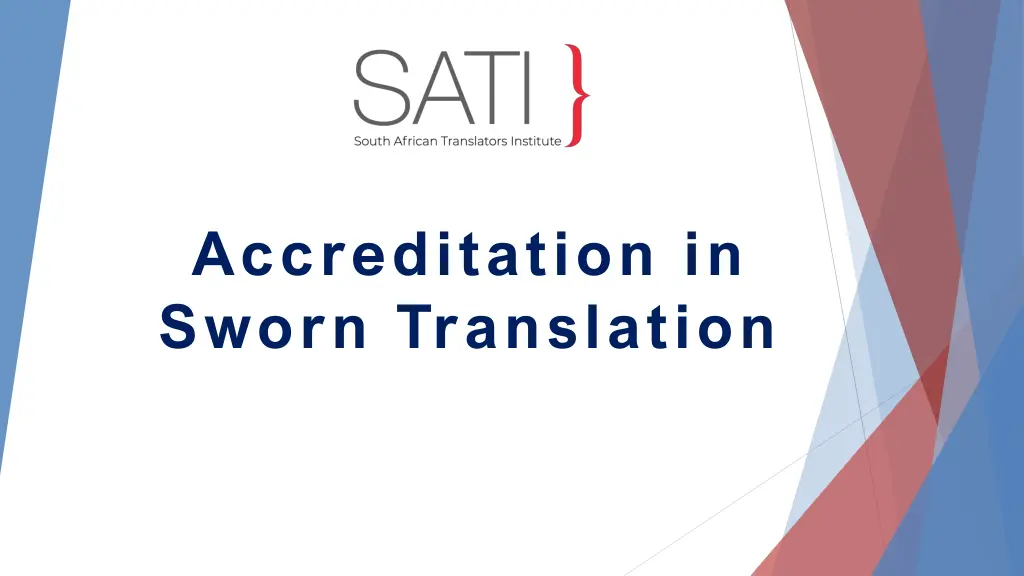
Sworn Translation Accreditation Process
Learn about the requirements and process for obtaining accreditation in sworn translation, including prerequisites, practice test, examination details, and the importance of legal knowledge. Find out the differences between the practice test and the examination, and what constitutes failing the practice test. Get ready to become an accredited sworn translator!
Uploaded on | 2 Views
Download Presentation

Please find below an Image/Link to download the presentation.
The content on the website is provided AS IS for your information and personal use only. It may not be sold, licensed, or shared on other websites without obtaining consent from the author. If you encounter any issues during the download, it is possible that the publisher has removed the file from their server.
You are allowed to download the files provided on this website for personal or commercial use, subject to the condition that they are used lawfully. All files are the property of their respective owners.
The content on the website is provided AS IS for your information and personal use only. It may not be sold, licensed, or shared on other websites without obtaining consent from the author.
E N D
Presentation Transcript
Accreditation in Sworn Translation
Prerequisites Active and paid SATI membership of at least three months (student membership does not qualify), plus A post-secondary language practice qualification plus evidence of at least three years language practice work in general translation (with professional references) If the applicant does not have a post-secondary language practice qualification, evidence of at least five years language practice work general translation, with professional references, will be required. OR Current SATI accreditation OR Membership or current accreditation by a FIT member association accepted by the SATI Council 51 SWORN TRANSLATION Presentation
Important information Candidates must take a compulsory practice test in sworn translation before applying for the exam. Candidates must study the SATI sworn translation manual (2020 edition) before applying for the practice test and exam. Candidates must follow the conventions in the SATI sworn translation manual (2020 edition) to pass the exam. Candidates should have a legal background or thorough knowledge of the legal systems relevant to the languages they are translating. Once the candidate passes the accreditation exam, they have to be sworn in at the High Court of South Africa to complete the process. The court application procedure is explained in the SATI sworn translation manual (2020 edition). 51 SWORN TRANSLATION Presentation
Practice Test The practice test in sworn translation will give candidates an idea of what to expect in the exam. After taking the test, candidates will be able to determine whether their legal knowledge is sufficient to pass the accreditation exam; and whether they understand the correct use of the required certification, translator s notes and format. Note that writing the practice test is compulsory, but passing the test is not a guarantee that the candidate will pass the exam. 51 SWORN TRANSLATION Presentation
Differences between Practice Test and Examination Practice Test 1 text 3 months' time limit Marked by 1 examiner Test paper is sent back with marks of the examiner Examination 5 or 6 texts 24 hours Marked by 2 examiners Complete report by accreditation officer is sent back 51 SWORN TRANSLATION Presentation
Failing the practice test In the practice test, the following will constitute a fail: - Two or more major errors or - One major error plus four minor errors or - Eight or more minor errors If the candidate fails the practice test, the following waiting periods apply for proceeding to the accreditation exam in sworn translation - No major errors and up to 15 minor errors: 3 months - No major errors and 15+ minor errors: 6 months - One or more major errors and up to ten minor errors: 6 months - One or more major errors and ten minor errors: 8 months 51 SWORN TRANSLATION Presentation
Preparing for the exam The SATI examination is designed for candidates who are already experts and seasoned translators and would like to add SATI accreditation to their qualifications. SATI provides a sworn translation manual (2020 edition) to assist candidates in preparing for the exam. 51 SWORN TRANSLATION Presentation
Venue and Date - A suitable date and time is agreed with the Accreditation Officer - On said date and time, the candidate will receive the password-protected examination documents via email - The candidate must complete and return the documents within 24 hours - The candidate must complete a Solemn Statement declaring that the translation is their own work - If any of these conditions are not complied with, the examination will be declared null and void, the examination fee will be forfeited, and the candidate will have to wait 12 months before they may apply again 51 SWORN TRANSLATION Presentation
Documents The examination texts will be provided via email to the candidate on the day of the exam. All texts must be translated. Texts types include academic certificates and transcripts, contracts, civil and personal documents (birth/death/divorce/marriage certificates), testimonials and wills, etc.. The texts will be black-and-white photocopies of actual documents but should be treated as originals for the purposes of the exam. 51 SWORN TRANSLATION Presentation
Tips When writing your examination, we recommend to: - Read the instructions carefully - Analyse each text for tone, register, style, emphasis, context, etc. - Plan time carefully - Adhere as closely as possible to the format of the original document - Use double spacing and font size 12 in Calibri or Times New Roman - Use a spellchecker and proofread carefully for typos, extra spacing and other odd formatting - If translating into English, always use English (UK) 51 SWORN TRANSLATION Presentation
In particular, make sure to check the following: - Proper names are spelled correctly - Numbers are typed correctly - No words on the page have been missed, including words that appear in the margins - All stamps, signatures, logos, drawings, etc. have been annotated - Each page has been correctly certified - All pages have been numbered 51 SWORN TRANSLATION Presentation
Resources The following resources are allowed and recommended when writing the examination: - Any dictionaries, glossaries, wordlists, reports, grammar guides and books on language - For sworn translation, specialist legal dictionaries (monolingual and bilingual) are essential - Internet resources 51 SWORN TRANSLATION Presentation
Assessment procedure The examination in editing is marked by two examiners. They do not have contact with each other, and the candidate remains anonymous. These examiners are professional and experienced accredited sworn translators. The final result is approved by the SATI Council. 51 SWORN TRANSLATION Presentation
Error types The following are considered MAJOR ERRORS: - Gross mistranslation where the meaning is lost completely - Omission of vital information - Insertion of information - Including alternate translations (instead of making a choice) - Failure in target language grammar (e.g. concord, tense, conjugation, prepositions, idiom) - Misspelling names of persons or places or reference numbers - Miscopying dates or numbers - Failure to certify at all 51 SWORN TRANSLATION Presentation
Error types The following are considered MINOR ERRORS: - Mistranslation where the meaning is distorted slightly / not changed - Omission of less important information - Inelegant target language grammar (e.g. word order, spelling, punctuation) - Typographical errors - Failure to certify every page 51 SWORN TRANSLATION Presentation
Failing The following number of errors will result in a fail: - Two or more major errors in one question or - Twenty or more minor errors overall or - One major error plus seven minor errors in one question or - Eight or more minor errors overall 51 SWORN TRANSLATION Presentation
Other The following aspects are also considered: - The target text must stand as a text in its own right, it must read like an original - The equivalent pass mark (e.g., in an academic exam) would be around 90% Candidates are allowed to use annotations (footnotes) to communicate with the examiner, for instance to explain a particular decision. However, annotations should be used sparingly. 51 SWORN TRANSLATION Presentation
Results The examination's assessment can take up to six weeks. Candidates will receive a report with a selection of examiners comments. Note: - Not all errors will be listed in the report - Candidates will not see their marked scripts - Candidates cannot discuss their results with the accreditation officer 51 SWORN TRANSLATION Presentation
Accreditation certification Successful candidates: -Will receive an accreditation certificate -Will be listed on SATI s website as accredited members - May use their accreditation status in communication with clients, i.e., in an email signature Please note: passing the exam does not make you a sworn translator, the process will be completed after the sworn-in event at the High Court. 51 SWORN TRANSLATION Presentation
Unsuccessful result If a candidate fails to meet the required standard for accreditation in sworn translation on the day of the examination, they may apply to re- take the exam after one year. The candidate should read the comments carefully and follow the advice given. 51 SWORN TRANSLATION Presentation
Appeal A candidate who wants to lodge an appeal should submit the application form and proof of payment within 8 weeks after having received the result. The original examination script will be marked by a third examiner and that report will be the final result. No further correspondence will be entered into after the final result is made available. If the Fail result is overturned, the candidate will be refunded for the appeal and will be considered accredited in sworn translation. 51 SWORN TRANSLATION Presentation
Accreditation validity Accreditation practitioner remains a member of SATI. remains valid as long as the language Accreditation practitioner wish to become re-accredited, they will have to re-apply to do the examination and pass it again. lapses when membership lapses. Should the 51 SWORN TRANSLATION Presentation
For more info, please email SATI's Accreditation Officer Erica du Preez: accreditation@translators.org.za




